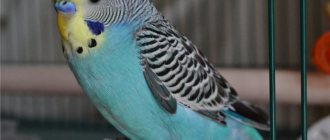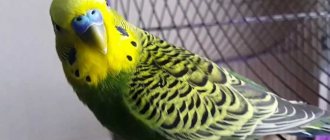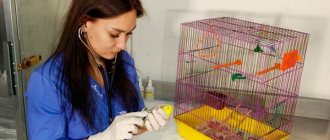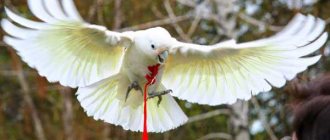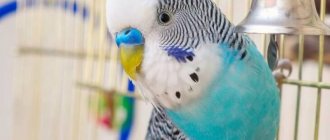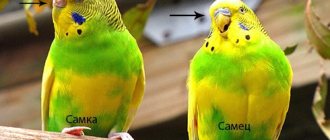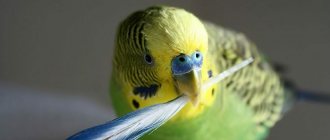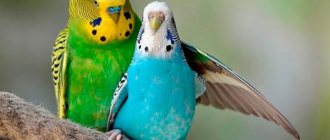Birds, unlike mammals, are much less likely to suffer from gastrointestinal problems. This is due to anatomical features: the excretory system of birds is united, all remnants of undigested food, liquid and solid, exit through the cloaca. However, constipation problems occur in budgies, which can cause serious harm to the pet and even cause its death.
Causes of constipation
If constipation occurs in a parrot, the owners themselves are to blame, since they do not provide the pet with adequate care. So, the main causes of this type of stomach upset include the following factors:
- presence of fatty foods in the diet;
- stale food or poisoning;
- long absence of water;
- unsanitary condition of the cell;
- psychological condition;
- stone or chalk.
| Causes of constipation | Why is this happening | What to do with a bird |
| Presence of fatty foods in the diet | There is an opinion that in nature parrots also feed on larvae, and not just a variety of grains. However, this is not a proven fact, and some owners believe it and prefer to feed their birds even fatty meat, since it is of animal origin. It is strictly forbidden to do this. | If you really want to feed your pet food of animal origin, then it is better to give him low-fat cottage cheese. With it, the bird will not have problems with the esophagus. |
| Stale, stale food or poisoning | A parrot, like many birds, does not understand food and does not understand what it can eat and what it cannot, so it eats everything. | Constantly monitor the quality of the food in your bird’s feeder. |
| Long absence of water | Water promotes good digestion and softening of stool. | You should constantly monitor the presence of water in the drinking bowl. Also, do not forget to change it every day and then you will not worry about constipation in your parrot. |
| Unsanitary condition of the cell | A cell contaminated with waste is a real breeding ground for pathogenic microorganisms. Therefore, failure to comply with hygiene rules increases the risk of contracting some kind of bacterial infection. | Regularly monitor the cleanliness of the cage. And once a month it would also be a good idea to disinfect it or at least wash it and all the accessories that are in it with chamomile decoction. |
| Psychological factor | Sometimes malfunctions in the intestines occur due to a change of owners. Therefore, do not be surprised if at first you observe constipation in your bird. | As soon as the bird gets used to it, problems with stool will disappear on their own. |
| Presence of chalk or stone | There are also cases that a stone or chalk that you give to your pet to scratch its beak causes it to retain stool. | If you notice that they are the cause of this kind of violation, then it is better to abandon them. |
Iatrogenic disease in a budgerigar
08/11/2017, 23:00, “Green Parrot Bird Hospital” < [email protected] >:
Good afternoon Point 3, Rigevidon, should be excluded from the treatment plan as it is extremely harmful to the health of your bird. Since your bird's long-term health problem is associated with the use of these medications. Since in this case we are talking about the iatrogenic nature of the parrot’s disease. It should be treated with courses of lipomin and sarcomin, 10 grains each, for 1 month. It is also better to show the parrot to our specialist from the Green Parrot bird hospital.
Sincerely, Vladimir Romanov
Saturday, August 12, 2021, 1:51 +03:00 from ko:
I live not far from Balashikha, when can I come and buy the drug and can consult with someone. Should I give Lipomin and Sarcomin together?
08/13/2017, 15:02, “Green Parrot Bird Hospital” < [email protected] >:
Anytime! from 10 a.m. to 11 p.m. on weekdays, on weekends from 10 a.m. to 8 p.m. It is better to give lipomin and sacromin separately in courses of 1 month. What is the name of the doctor who consulted you before us? Sincerely, Vladimir Romanov Sunday, August 13, 2021, 18:39 +03:00 from ko:
I was consulted remotely, on M and B the doctor is known by the nickname Zosia
I see she is trusted and recommended on many resources.
08/13/2017, 23:38, “Green Parrot Bird Hospital” < [email protected] >:
Poor birds! I would advise using the recommendations of real doctors, and not those who use nicknames and are not known as real individuals! I made a slight mistake in the name of the drug - (spelling error) - sarcomine!
Sincerely, Vladimir Romanov
Sunday, August 13, 2021, 23:50 +03:00 from ko :
It’s okay, we have at least some choice from the Moscow region, and even then there’s almost none, I’m talking about normal ornithology. And in the regions, provinces, and in general, what people say is terrible. A man with a wavy bird comes to the veterinarian; the bird’s tumor is no longer frail on its belly, like ours. And he tells him, go with God, this is a bird’s pregnancy, and the tumor was discovered six months ago. And another freak in a similar situation complained so much that he crushed everything inside, and these are real stories, here are real doctors. Here I live in the Moscow region, and even in my city they refuse to do x-rays, and I won’t bring the bird to you, she was in deep shock after a 3 km trip, she was choking with fear. So, alas, in Raska the situation with the treatment of birds is very bad.
Hold on! But by the way, bird hospitals abroad are also not located in every gateway. For example, in the United Arab Emirates in Abu Dhabi. That is, the owner has to travel hundreds of kilometers for help! There are two hospitals in New York. Things are no better in Germany! So not everything is so bad in Russia. Sincerely, Vladimir Romanov
Constipation in a parrot photo
Symptoms: what might the owner notice?
With diarrhea, the bird changes its behavior. This is immediately noticeable, so the breeder must respond to the changes in a timely manner and call/visit the clinic to a veterinarian ornithologist.
Parrot with diarrhea:
- looks sleepy, apathetic;
- loses activity;
- stops flying, sits ruffled;
- may tremble.
A characteristic feature is that the bird does not sit on a perch or vertically on the bars of the cage, but on the bottom, tray, or corner. Refuses water and food, does not respond to the owner's calls, stroking, toys.
The plumage does not fit tightly to the body; the feathers around the cloaca are dirty.
Symptoms of constipation
It is not easy to notice that a parrot is constipated. This can only be done by a very attentive owner. First of all, changes that are associated with the color and quality of the litter should catch your eye. If there are problems with the intestines, it becomes denser and acquires a gray or light yellow color. Also, with this disorder, the bird may lose its appetite.
If constipation has been going on for quite a long time, then, taking a closer look at the bird, you will see a lot of changes. The main ones include:
- Depressed mood of the bird.
- No droppings in the cage.
- Very long intervals between bowel movements.
- Frequent attempts by the parrot to pluck a place in the cloaca area.
- The pitiful squeak of a bird.
- Presence of bloating.
If you have already noticed such changes with your pet, then it is necessary to begin treating it as quickly as possible. After all, we can no longer talk about days, but even about hours, and if you do not have time to help the bird, it will die.
Especially dangerous is litter that has acquired an orange or red color. This color indicates the presence of a bacterial infection, poisoning, and damage to the gastrointestinal tract.
Wavy has diarrhea
From: Alexander < [email protected] > Tel.: 890255 Message: Hello... the wavy has been sick for the 5th month... diarrhea... at first I treated it as usual... charcoal, rice decoction, chamomile... then I called a doctor in Moscow on the forum of the Zoovet website... but answered the consultant... and no matter how much you treat it, it doesn’t help... now I feed porridge with 5 grains and dairy-free and cook the porridge that way... it almost doesn’t fit in the feeder... or it fits and it’s not clear whether it’s eating or not, or maybe you’re pretending... I also give PANZINORM ...tried to give NISTATIN and BIFUMBACTERIN...DID NOT HELP, she says either an infection or something wrong with the pancreas...help me, I don’t know what to do...
Good afternoon I understand that he has been sick for five months, but it’s not clear what age your parrot is?
Sincerely, Vladimir Romanov
Treatment and care of birds
If your parrot has just become constipated and he doesn’t defecate very often, you can try to deal with the problem yourself. To do this you need:
- throw away old food;
- change the water;
- remove stone, chalk and sand from the cage;
- mix some flax seeds into the food, which act as a mild laxative;
- organize regular walks around the apartment for the bird.
If your pet has not defecated for 5 or 7 hours, you can give it 1 drop of flaxseed or pumpkin oil in its beak.
A budget option for purchasing a male budgie
From: Julia Tel.: 8952 Message: Interested in a budget option for purchasing a HEALTHY male budgerigar, preferably green color (not important), age: the younger the better. Cost, terms, payment procedure? Can I buy a cage (carrying) from you?
Good afternoon Yes, you can buy it - the cost is 1000 rubles, Any period of time - you choose, any age - write down which one you need. There is no carrying case, but you can choose any cardboard shoe box as a budget option. The payment procedure is any, both by cash and by bank transfer.
Sincerely, Vladimir Zyablikov
Budgerigar poops liquid
Diet features
For spastic constipation, limit foods and dishes that irritate the mucous membranes of the gastrointestinal tract. These include:
- vegetables rich in essential oils: radishes, garlic, onions, etc.;
- smoked meats, marinades, salty foods;
- pepper dishes and spices;
- fried, fatty foods;
- baked goods, soda, strong coffee and tea, etc.
The diet can be developed individually, taking into account the needs and general health of a person.
The basis of the daily diet can be cereals, low-fat fish, meat, and poultry. It is important to eat first courses - soups with low-fat broth. Fresh vegetables and fruits are good for constipation because they contain a lot of dietary fiber. But you should monitor your condition and intestinal reaction, especially if you are already taking additional fiber.
Mousses, fermented milk products, dried fruits, and cottage cheese casseroles are suitable as desserts. You should avoid confectionery, chocolate, cocoa, and baked goods.
Bread should be chosen from wholemeal flour. Fresh white bread is prohibited; small amounts of day-old bread are allowed. Rusks can make the problem worse.
What can and cannot be done at home?
The parrot can be warmed under an incandescent lamp or on a hot (up to 40 C) heating pad if it is clearly trembling or ruffled. The exception is when there is visible or hidden blood in the litter (internal bleeding, which increases with warming). It can be detected by dropping hydrogen peroxide on the excrement. With blood it gives a profuse foamy reaction.
Usually the parrot is placed in a box, a lamp/heating pad is placed, space is needed so that the bird can move away from the heat source if it overheats.
The option of force-feeding birds remains controversial. The owner will not find out what exactly caused the diarrhea at home, and even feeding the recommended food does not always give a positive result.
Therefore, veterinarians at the RosVet VC advise calling an ornithologist to your home at the first sign of illness so that he can examine the bird. Transport to the clinic in such situations can cause additional stress and deterioration of the condition, and only when the doctor recommends placing the parrot in a hospital for observation is it advisable to accept the recommendations.
If your parrot begins to walk loosely (diarrhea), or additional signs of illness appear - do not hesitate! Call the RosVet VC, calls are accepted 24 hours a day. The team is called to your home 24 hours a day at a time convenient for the owners of animals and birds.
Diagnostics
There is considerable controversy regarding the appropriate way to diagnose LPR.
Most patients are diagnosed clinically, based on symptoms associated with LPR.
During laryngoscopy (examination of the larynx), swelling and hyperemia (redness) of varying degrees are noted. However, the relatively weak correlation between symptoms and endoscopic findings argues against the use of endoscopic diagnostic methods.
The Reflux Symptom Score and Reflux Symptom Index are well suited for both diagnosis and monitoring response to therapy.
Daily Ph-metry with a dual sensor probe, despite its excellent sensitivity and specificity, is questioned, since the results of this diagnostic method often do not correlate with the severity of symptoms.
Another diagnostic option may be empirical PPI therapy.
Laryngophangeal reflux and GERD
Although stomach acid is common to both LPR and GERD, many differences exist, making LPR a distinct clinical entity.
- A prerequisite for GERD is heartburn, which is reliably observed only in 40% of patients with LPR.
- Most patients with GERD have evidence of esophagitis on biopsy, while patients with LPR have evidence of esophagitis in only 25% of cases.
- GERD is thought to be a problem of the lower esophageal sphincter and occurs primarily when lying down. In contrast, LPR is seen primarily as a problem of the upper esophageal sphincter, and occurs primarily in an upright position during exercise.
- To form LPR, much less acid exposure is required than with GERD.
There are significant differences between the mucous membrane of the esophagus and larynx.
- The upper limit of normal for acid reflux into the esophagus is considered to be up to 50 episodes per day, while 4 episodes of reflux into the larynx is no longer considered normal.
- In the larynx, unlike the esophagus, which eliminates acid through peristalsis, refluxate persists much longer, causing additional irritation.
- The epithelium of the larynx is thin and poorly adapted to combat caustic chemical damage from the same pepsin and acid.
Symptoms of coronavirus COVID-19
Coronavirus
COVID-19
3133 January 27
IMPORTANT!
The information in this section cannot be used for self-diagnosis and self-treatment. In case of pain or other exacerbation of the disease, diagnostic tests should be prescribed only by the attending physician. To make a diagnosis and properly prescribe treatment, you should contact your doctor. Definition
The SARS-CoV-2 virus spreads in microscopic particles of fluid released by a sick person during coughing, sneezing, talking, singing or heavy breathing and gets onto the mucous membranes of the nose, mouth or eyes of another person.
In addition, the virus can also spread through household contact, when particles with the virus located on surfaces or objects enter the mucous membranes of the respiratory tract through the hands.
Aerosol transmission occurs in closed, crowded and poorly ventilated areas.
The airborne dust (aerosol) transmission route is realized through the spread of aerosols (droplet nuclei) suspended in the air, the size of which is <5 microns. Due to their small size, aerosols can be transported over long distances and remain in the air for several hours. It must be remembered that aerosol-producing devices (nebulizers, halochambers, etc.) are prohibited for use in healthcare institutions during the COVID-19 pandemic.
Symptoms of mild COVID-19
Most common symptoms
- The main symptom (80-90%) is any increase in body temperature (even low-grade - 37-37.5°C).
- The cough is dry or with a small amount of sputum (60-80%).
- Increased fatigue (40-50%).
Less common symptoms
- Sudden loss of smell and/or taste (60-80%).
- Nasal congestion or mild rhinorrhea (5%).
- Conjunctivitis or redness of the eyes (1-2%).
- Sore throat (14%).
- Headaches, dizziness (8-14%). Immediately after the end of the incubation period, migraines of varying severity may appear.
- Pain in joints and muscles (11-15%).
- Skin rashes (8%).
- Diarrhea, nausea, vomiting (up to 20%).
- Chills (11-13%).
Those who have had a mild form of COVID-19 infection compare the sensations with the course of a common respiratory disease.
Symptoms of COVID-19 in severe and moderate forms of the disease
Most common symptoms
- Shortness of breath, rapid breathing (55%).
- Increased cough, appearance of sputum (30-35%).
- Hemoptysis (5%).
- Loss of appetite (20%).
- Confusion (9%).
- Sensation of constriction and congestion in the chest (> 20%).
- Body temperature above 38°C (80%) for more than 5 days.
- Blood oxygen saturation according to pulse oximetry (SpO2) ≤ 95% (up to 20%).
Less common symptoms
- tachycardia,
- vitamin D deficiency,
- irritability,
- convulsions,
- anxiety,
- depressed state
- sleep disorders.
Important! Symptoms may not be detected during the incubation period of COVID-19 or may appear in any combination (for example, without fever). The exact diagnosis is determined by the doctor based on the results of examinations.
Patients over 65 years of age may experience an atypical picture of the disease, which includes delirium (cloudedness of consciousness), speech impairment, movement disorders, as well as more severe and rare neurological complications - stroke, inflammatory brain damage, and others.
The majority (about 80%) of patients who develop symptoms recover without hospitalization. Approximately 15% of patients develop a severe form of the disease that requires oxygen therapy, and 5% develop an extremely severe form that requires treatment in an intensive care unit.
Differences between the new coronavirus disease COVID-19 and ARVI and influenza
COVID-19 also refers to ARVI - acute respiratory viral infections characterized by similar symptoms: cough, runny nose, fever, headache, sore throat and sore throat. The most clearly defined clinical picture is caused by influenza viruses, parainfluenza, and adenoviruses. Coronavirus can be more severe than other acute respiratory viral infections, leading to complications and even death. That is why it is extremely important to distinguish the new type of coronavirus from a relatively harmless cold.
What is the difference between coronavirus and ARVI?
- Longer incubation period. For ARVI, 2-3 days are enough to go into the acute phase, but coronavirus takes up to 2 weeks.
- Unlike other acute respiratory diseases, coronavirus causes a low body temperature of 37-37.5°C, which can last a relatively long time (up to 7 days).
- A cough when infected with coronavirus is often long-lasting, dry, painful and may be accompanied by chest pain.
- Coronavirus infection can cause digestive upset (diarrhea, nausea, vomiting); such phenomena are rare with ARVI in adults.
- ARVI is usually cured in 7-10 days, and COVID-19 on the 7-8th day in a certain percentage of people can move to the next stage, when shortness of breath and respiratory failure appear.
Only a laboratory test will help you accurately name the type of pathogen and establish the disease (coronavirus, ARVI, influenza).
What is the difference between coronavirus and flu
It should be noted that COVID-19 and influenza have much in common:
- transmitted by airborne droplets and contact;
- may manifest as aching joints, headache, severe weakness and a general feeling of weakness;
- Intestinal disorders may occur.
Main differences:
- The flu begins acutely with an increase in temperature immediately to febrile values (39-40⁰C). Symptoms of general intoxication come to the fore: headache, weakness, pain in muscles and joints, lacrimation, pain in the eyes.
- Coronavirus develops gradually - from general malaise in the first days to severe symptoms, including a significant increase in body temperature after a week.
It is important that a doctor determine the difference between coronavirus and influenza, since both diseases can lead to dangerous complications, including pneumonia.
If a person has the flu and not coronavirus, he also needs medical care and treatment under the supervision of a therapist. Other diseases with similar symptoms
Pneumonia, including atypical.
Allergies. Shortness of breath, problems with smell, and other symptoms may occur as a result of exposure to allergens. The problem is solved by antihistamines, which are ineffective for viral infections.
Bronchial asthma, which also makes itself felt by difficulty breathing and a painful cough, but is non-infectious in nature.
Are symptoms different in children and adults?
Children make up only about 2% of all COVID-19 cases. At the same time, they tolerate coronavirus infection more easily and are often asymptomatic carriers.
The course of COVID-19 in children of different ages:
From 1 year to 3 years
The infection usually manifests itself as a mild illness. There are no characteristic symptoms of COVID-19. Sometimes there is a loss of appetite, which goes away after 2-3 days and does not affect the baby’s general well-being.
From 3 to 7 years
Children at this age are sick for about seven days and recover without complications. They may experience hoarseness and mild nasal congestion. There is no cough, occasional sneezing is possible.
From 7 to 17 years old
Primary schoolchildren and adolescents may experience a slight increase in body temperature and mild malaise. A dry cough is possible, and even less often - a headache.
According to Rospotrebnadzor, a mild form of the disease is usually due to the patient’s strong immunity.
The immune system of children and adolescents is usually well prepared to fight viruses. They can become infected, but their disease is milder or completely asymptomatic.
Stages of disease development taking into account symptoms
Symptoms of coronavirus in an adult by day
1-3 days. The disease begins with mild malaise, a slight increase in temperature, nasal congestion and muscle pain, as with ARVI or influenza.
3-5th day. Body temperature rises, and a mild, superficial cough is possible. The sense of smell may disappear, and taste sensations may change greatly. Digestive disorders occur, including diarrhea. This period is considered the culmination of a mild form of COVID-19.
5-10th day. An important period for determining the severity of coronavirus infection. 80% of people sick with COVID-19 experience improvements, which can lead to a full recovery in a few days. The second scenario involves a worsening of the condition, which is manifested by an increase in the number and severity of symptoms. With this development of events, the patient develops a severe runny nose, debilitating cough, chills, body pain, and shortness of breath.
10-12th day. This period is characterized by severe shortness of breath, chest pain, progression of weakness, and pallor, which indicates the development of pneumonia. Damage to the lungs leads to oxygen starvation. Hospitalization required. This condition is considered moderate.
12-14th day. With COVID-19, 75% of patients with viral pneumonia begin to recover on average 2 weeks from the onset of the disease. However, those who develop severe disease may require mechanical ventilation.
14-30th day. It takes on average up to two weeks from the onset of a serious complication to recover from a severe form of pneumonia caused by coronavirus.
But even after complete recovery, mild shortness of breath may persist, weakness and malaise may appear for a long time (up to several months).
Clinical variants and manifestations of COVID-19
- Affects only the upper respiratory tract.
- Pneumonia without respiratory failure.
- Acute respiratory distress syndrome (pneumonia with acute respiratory failure).
- Sepsis, septic (infectious-toxic) shock.
- Syndrome of disseminated intravascular coagulation, thrombosis and thromboembolism.
- Blood oxygen saturation is less than 88%.
Patients with critical COVID-19 develop vascular endothelial dysfunction, bleeding disorders, thrombosis, and thrombotic microangiopathy.
A cytokine storm in COVID-19 is the body’s response to an inflammatory process, leading to immune cells attacking not only the virus, but also the tissues of the body’s own. The consequence of this can be the destruction of tissues and organs, and, as a consequence, the death of the body.
It is very important that sometimes COVID-19 is dangerous not only because of pneumonia and its complications, but also because it has a negative effect on blood vessels, the brain and the heart, which increases the risk of stroke. In such cases, the patient experiences dizziness, fainting may occur, the face turns blue and the muscles become numb.
Symptoms indicating the healing process
Attention!
The time intervals for the course of the disease are arbitrary; they depend on the individual characteristics of the organism. COVID-19 in mild form usually lasts no more than 14 days. But only an antibody test can confirm final recovery. Given the severity of the disease, the recovery process can take place in different ways. The criterion for recovery is if two consecutive tests for coronavirus using the PCR method gave a negative result.
Change in litter color
For the most part, the color of the stool depends on what food the parrot ate on the eve of its last bowel movement. The normal state of droppings is considered to be dense and fairly hard, worm-like feces of a brown-green color.
Ornithologists who record the appearance of a bird's stomach disorder first of all pay attention to the change in color in the aftermath of defecation. Based on this or that shade, the doctor can make a specific diagnosis, in some cases without even resorting to additional research - which means you need to contact him as soon as possible.
White droppings on a budgerigar
In a normal state of health, in the parrot's droppings, in addition to the main dark green fecal mass, there is a separate light fraction. It is represented by a thick substance consisting of urea and a small amount of fecal fluid.
If, during defecation, a strong increase in the white fraction is observed in the parrot’s feces, we can conclude that there are disturbances in the field of protein metabolism in the pet’s body. Thus, the light color of stool signals the presence of lesions of the pancreas, as well as possible gout. The occurrence of various disorders in the area of defecation corresponds to the appearance of symptoms of any disease.
An excessive number of disorders acquired by a parrot affects the condition of its esophagus.
Black droppings
Blackening of the droppings is an extremely dangerous signal, indicating the presence of major problems in the pet’s health. The dark shade of stool appears due to internal bleeding that occurs in the upper sections of the intestinal tract. Blood released from initially unintended channels mixes with the droppings, gradually coagulates and acquires a black tint.
Another possible reason for darkening of stool is problems with digestion of food. Food that has not been properly processed in the pet’s stomach begins to darken as a result of gradual rotting processes. The main causes of such problems include diseases associated with fecal obstruction, as well as inflammatory pathologies in the intestinal area.
Green droppings
Liquid green droppings in a budgerigar are a signal indicating the presence of disturbances in the functioning of the intestines. Greening of stool occurs as a result of poisoning resulting from poor-quality food or water. Also, the droppings become green in cases where any inedible substances have entered the parrot's intestines.
If your budgie or cockatiel begins to have diarrhea with green feces, the owner should take immediate action or consult a professional. Green poop in a parrot is a real problem, the cause of which only an ornithologist can figure out.
An excessive number of disorders acquired by a parrot affects the condition of its esophagus.
Bloody droppings
It would seem that feces with blood is a visually noticeable signal, the identification of which is not difficult. However, a reddish tint is often caused by food of a corresponding color that is included in the parrot's diet on the eve of defecation. Don't worry if you see "blood" in your pet's droppings after he ate carrots or beets.
You can determine that there is blood in your pet's stool using hydrogen peroxide. If foaming and hissing begins when drops of the composition hit a particle of droppings, we can conclude that the bowel movements are indeed mixed with blood.
Similar problems are typical for feathered friends suffering from worms or infectious diseases of the lower intestine and cloaca.
Watery droppings
Watery droppings are one of the characteristic signs of polyuria. The presence of such a pathology can be determined by the composition of the feces: they should have a dense consistency, but defecation occurs with copious amounts of fluid.
The reasons that influence the occurrence of watery droppings can be: excessive amounts of succulent food, disturbances in the functioning of the renal complex, worms and helminths, stress or lack of vitamin A. An excessive number of disorders acquired by the parrot affects the condition of its esophagus.
Previous
DiseasesAllergy to parrots in adults and children
Next
DiseasesWhat to do. when does a parrot lose its feathers
